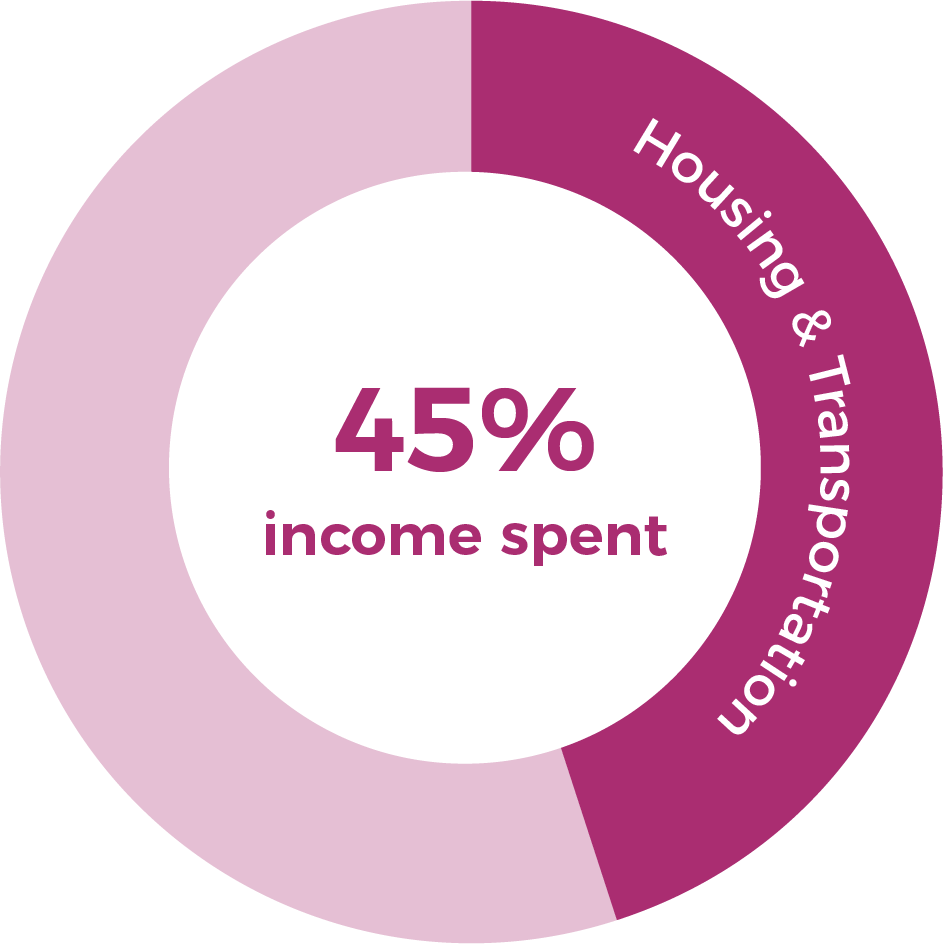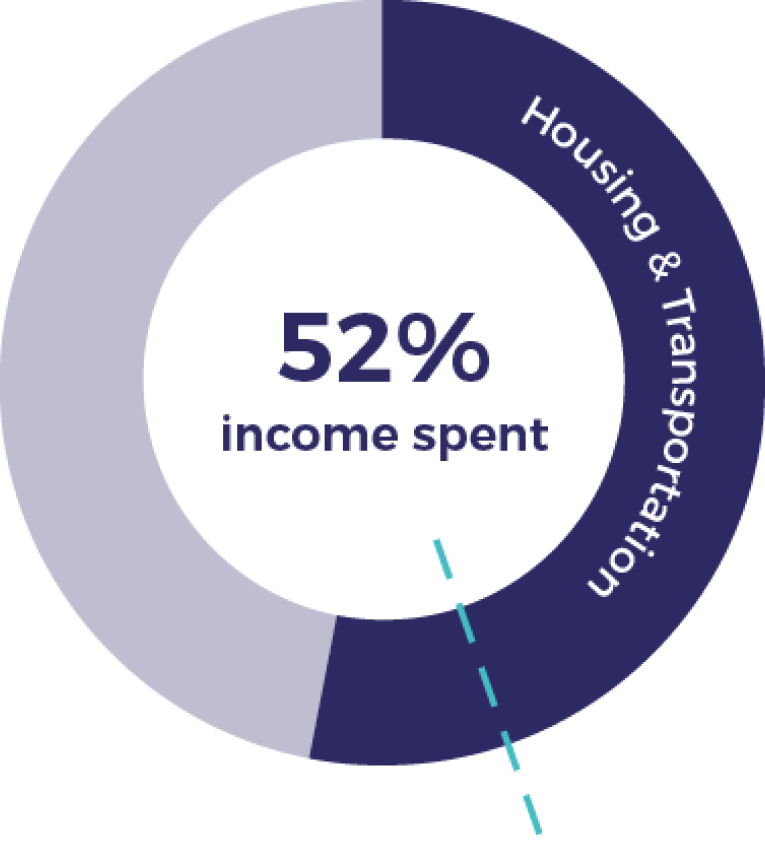Equity
While there is no single solution to tackling economic inequalities, focusing on improving transportation choices, accessibility and increasing affordable housing is a step in the right direction to enhancing equity in our region. Transportation access is a crucial element in providing access to education, jobs, and housing as a means to increase one’s economic and social mobility.
Equitable Opportunity in the CONNECT Beyond Region
Despite the exponential population and employment growth and continuous development that the region has experienced over the past few decades, stark social and economic inequalities still exist throughout our region.
In 2013, the groundbreaking study “Where is the Land of Opportunity? The Geography of Intergenerational Mobility in the United States”, which was conducted by researchers at Harvard University and UC Berkeley, highlighted the very real economic and social inequality that exists in our region. The research study examined intergenerational mobility for various metropolitan areas in the United States and found that Charlotte ranked last among large U.S. cities for intergenerational mobility.
The study’s researchers found that where a child grows up is a significant contributing factor to whether that child will experience economic and social mobility, specifically the ability of a child born into the lowest income bracket to rise into the top income bracket as an adult.
The researchers found that for a child born into poverty in Charlotte, North Carolina, the chance of that child rises to the upper-middle class or upper class (the top 20 percent income bracket) as an adult is only about 4.4 percent.
In response to this research study, the Charlotte-Mecklenburg Opportunity Task Force was formed and between 2015 and 2016, this community member Task Force spent 18 months studying the “complex issues that impact generational poverty and access to opportunity.” In their final report, this Task Force suggested improving access to public transportation and to workforce housing as two key strategies to help “tackle intergenerational poverty and break down barriers to economic opportunities” in the Charlotte community.
Why is Transportation Important?
We know that transportation access is a crucial element in providing access to education, jobs and housing as a means to escape poverty and increase one’s economic and social mobility. Lack of reliable transportation can be a substantial barrier to opportunity and social capital. If there are limited or no public transportation options, especially for low-income individuals and families, this creates significant barriers to being able to get to work, access healthcare, shop for groceries, take your children to school, access other public services and participate in activities and social events throughout our region.
In a 2018 report, the North Carolina Department of Transportation explained that "for lower income households, access to these important [key] destinations by means other than a car help keep transportation costs low, thereby reducing the overall costs of living." The Leading on Opportunity: the Charlotte-Mecklenburg Opportunity Task Force Report suggested improving access to public transportation as a key strategy for enhancing equity in our region.
A key recommendation for implementing this strategy was to focus on increasing "transportation options for families who don't have their own vehicles."
Increasing access to job opportunities can help to boost social and economic mobility, especially for individuals living in low-income areas. To increase access to job opportunities, the Urban Institute suggests improving access to public transit and creating more affordable housing near transit stations and job opportunities by encouraging transit-supportive land use patterns.
Since enhancing transportation choices is the cornerstone of the CONNECT Beyond project, addressing how to improve equitable access to transportation for all of the region's residents are going to be an important consideration of this planning initiative. Not only must we focus on improving equitable access to transportation within our urban areas, but we must also pay close attention to how we can improve connectivity between rural and urban areas in our region.
Housing Affordability
There is an indisputable connection between housing and transportation, which is why it is so important that affordable housing is a key discussion point in any conversation about region transportation planning.
According to the Opportunity Task Force Report, the City of Charlotte has a deficit supply of affordable housing and needs about 34,000 more affordable housing units for individuals who make 60 percent or less than the area median income. While it has been widely recognized that the City of Charlotte has been struggling with housing affordability in recent years, the Carolinas Urban-Rural Connections study, a research and community-engagement study that is being conducted by the UNC Charlotte Urban Institute, found that rural areas around Charlotte are also “experiencing a severe housing shortage and affordability crisis.”
So what exactly is considered "affordable housing"?
Financial figures about housing costs do not tell the whole story though and to determine whether housing in an area or region is affordable, it is essential to also consider related transportation costs.
The Center for Neighborhood Technology’s Housing and Transportation Affordability Index
To better understand the connection between housing and transportation costs, the Center for Neighborhood Technology developed the Housing + Transportation Affordability Index, which provides a more nuanced view of housing affordability within a community and region. While traditional housing affordability measures consider a home affordable if its price is less than 30 percent of a family’s income, the H+T Affordability Index goes a step further considering the transportation cost related to the home’s location, including the cost of commuting and other daily travel needs.
When a home is located far from the region’s job centers and public transportation services, the transportation costs are significantly higher. When a home is near job centers, retail and transit, household transportation costs are lower, making a home more “location-efficient”. Using the H+T Affordability Index, a home is considered affordable if the cost of housing and transportation combined do not exceed 45 percent of a family’s income.
According to the Housing and Transportation Affordability Index (H+T Index), the average resident in the Charlotte-Concord-Gastonia region spends about 25 percent of their income on transportation and about 27 percent of their income on housing, which combined is about 52 percent of their income. The H+T Index also estimates that the average household in the Charlotte-Concord-Gastonia region drives about 22,673 miles per year and spends about $13,241 annually on transportation.
Housing + Transportation Affordability Index Recommendation

Charlotte-Concord-Gastonia Region Resident Average

The CONNECT Beyond initiative addresses regional disparities through recommendations to improve public transportation and coordinate land use.
